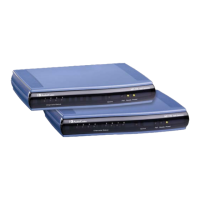Version 5.8 79 September 2009
SIP User's Manual 3. Web-Based Management
Parameter Description
Byte Rate
[AccessList_Byte_Rate]
Expected traffic rate (bytes per second).
Burst Bytes
[AccessList_Byte_Burst]
Tolerance of traffic rate limit (number of bytes).
Action Upon Match
[AccessList_Allow_Type]
Action upon match (i.e., 'Allow' or 'Block').
Match Count
[AccessList_MatchCount]
A read-only field providing the number of packets accepted / rejected
by the specific rule.
3.3.3.4 Configuring the Certificates
The 'Certificates' page is used for the following:
Replacing the server certificate (refer to ''Server Certificate Replacement'' on page 79)
Repl
acing the client certificates (refer to ''Client Certificates'' on page 81)
Reg
enerating Self-Signed Certificates (refer to ''Self-Signed Certificates'' on page 83)
Upd
ating the private key (using HTTPSPkeyFileName, as described in the Product
Reference Manual).
3.3.3.4.1 Server Certificate Replacement
The device is supplied with a working Secure Socket Layer (SSL) configuration consisting
of a unique self-signed server certificate. If an organizational Public Key Infrastructure (PKI)
is used, you may wish to replace this certificate with one provided by your security
administrator.
¾ To replace the device's self-signed certificate:
1. Your network administrator should allocate a unique DNS name for the device (e.g.,
dns_name.corp.customer.com). This DNS name is used to access the device and
should therefore, be listed in the server certificate.
2. If the device is operating in HTTPS mode, then set the parameter 'Secured Web
Connection (HTTPS)' to 'HTTP and HTTPS' (0) (refer to ''Configuring the General
Security Settings'' on page 83) to e
nsure you have a method of accessing the device
in case the new certificate doesn’t work. Restore the previous setting after testing the
configuration.

